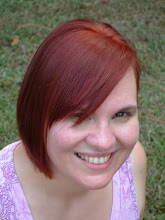Last night I had options. I could have gone to Mother's Night Out with my home-school group and seen a movie. I was really looking forward to my first Wednesday Night Craft night. And I really want to start going to Wednesday's of Wonder at my local church and do cool things with the kiddos. I had planned on doing all three, although the plan on how I can do 3 things in one night hadn't been hammered out yet.
But no, I was home making soap because 2 of the 4 batches I made Tuesday night flopped.
Botched Soap #1: Oatmeal Milk & Honey Soap
The reason I take copious notes when I do anything is because I never remember what I do. I'm well known for my bad memory. So why I didn't read my notes from the last time I made Oatmeal Milk & Honey soap, I don't know. Note #1: combine the oils and lye water when both are between 90 and 100 degrees. I combined them at 120. Note #2: hand stir the additives. I used the stick blender. #3: cover the soap with waxed paper, not plastic wrap - the intense heat melts the plastic wrap. Guess what I covered it with. And #4: do not insulate. Oh, I covered it with a nice warm blanket.
So when I woke up yesterday morning, there was a 1/4 inch layer of oil on top of the soap and it did not look good. Plus the plastic wrap had shriveled from the heat, which was intensified by the insulation.
Honey does something to the chemical reaction the soap goes through during the first 48 hours. It intensifies that reaction, which is why I can't treat it like just another batch of soap. My guess, due to the magnified heat, the lye more quickly broke down and rebonded with the different components of the fats. But the heat was high enough that all unclaimed fat floated to the top instead of suspending in the soap. So what is left on the bottom is soap that's 100% saponified. It's probably still soap, just strong soap. That's my educated guess.
I did remake it, and this time I followed my notes. It still went through different stages than normal soap, and it was fun to show the kids "chemistry in action." After adding the honey, the soap turned a golden brown. About 10 minutes later, it was a pumpkin orange and much hotter to the touch. 30 minutes later, it was brown and the center, where the heat was most intense, was dark brown, and even hotter to the touch. This morning, it's now back to a beautiful golden brown - all one solid color and cool to the touch. No oil on the top. No melted plastic wrap. Looks perfect!
I don't make this type of soap often enough not to follow my notes. It's been about 5 years since I made it. That was about the time I started my quest for the perfect bar and stopped playing with additives.
Side note: My Quest for the Perfect Bar of Soap
About 5 years ago, I started trying to discover the formula for the perfect soap. I do realize that the definition of a perfect soap is purely subjective, but I have my own ideals.
The Perfect Bar of Soap (for me) has 6 Different Qualities:
1. A good quantity of Lather
2. A good stability of Lather
3. A variety of bubble size
4. Moisturizing & conditioning to the skin
5. A sufficient hardness so that it lasts longer than commercial soaps
6. Cleans well
I’m still on the quest, and I’m pretty close. Ever since I started this quest, I stopped playing with adding things like oatmeal, honey, and carrot juice and concentrated solely on base oils. I have gotten to know my base oils and each one's attributes very well.
Back to the botch job . . .
Botched Soap #2: Green tea and Hibiscus
I wanted to start experimenting with infusions - steeping herbs in either oil or water. Oil infusions I've done many times, but I wanted to try infusing green tea and hibiscus in the water used for the lye. Green tea has a great scent, and hibiscus makes a lovely deep red when steeped.
I made a strong tea from hibiscus and green tea and let the tea come back to room temp. When I poured the lye into the tea water, it went from a deep burgundy to bright green - think Christmas green. In the back of mind, I instantly heard a lecture snippet from a chemistry class I took years ago informing me many natural plants can be used as homemade litmus tests, such as cabbage and HIBISCUS!
My idea of a lovely deep red soap was dashed when my water turned from red to green to brown within seconds. The jury is still out on this soap, but it may very well become my future laundry soap. My homemade laundry soap is where botched soaps go to die in my house.
As of this morning, I have 28 of the 30 batches I need for my auction donation, and I have until Friday night to finish. Now to decide on the last 2 batches.
Thursday, February 18, 2010
Subscribe to:
Post Comments (Atom)


No comments:
Post a Comment